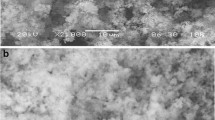Abstract
The effects of Nd(III)/Am(III) complexation with sulfate were studied by 1) re-examining existing data for the Am−SO4 system using more, advanced aqueous electrolyte models valid to high concentration to obtain reliable thermodynamic data for SO 2−4 complexes or ion interactions with Nd3+ and Am3+ and 2) conducting experimental solubility studies of NdPO4(c), an analog phase of AmPO 4 (c), a possibly important phase in high level nuclear wastes, in the presence of SO 2− 4 to test the newly developed thermodynamic model and show the possible influence of sulfate in a repository environment. The data showed that the increase in the solubility of NdPO 4 (c) resulted primarily from the increase in ionic strength. Slightly higher observed Nd concentrations in the presence of sulfate, as compared with concentrations predicted at the experimental ionic strengths, resulted from the weak complexes or ion interactions involving Nd3+−SO 2− 4 . The Pitzer ion interaction parameters, applicable to 0.5m sulfate, were obtained for Am3+−SO 2− 4 from a reinterpretation of known solvent extraction data. These parameters are also consistent with literature data for Am3+/Na+ exchange and solvent extraction in the presence of sulfate. When used for the analogous Nd3+−SO 2− 4 system to predict NdPO 4 (c) solubility in the presence of sulfate, they provided excellent agreement between the predicted and the observed solubilities, indicating that they can be reliably used to determine Nd3+ or Am3+ ion interactions with SO 2− 4 in all ground waters where SO 2− 4 is less than 0.5m
Similar content being viewed by others
References
T. Sekine,Acta. Chem. Scand. 19, 1469 (1965).
A. Aziz, S. J. Lyle, and S. J. Naqvi,J. Inorg. Nucl. Chem. 30, 1013 (1968).
W. J. McDowell and C. F. Coleman,J. Inorg. Nucl. Chem. 34, 2837 (1972).
P. R. V. Rao, S. V. Bagawde, V. V. Ramakrishna and S. K. Patil,J. Inorg. Nucl. Chem. 40, 123 (1978).
P. K. Khopkar and J. N. Mathur,J. Inorg. Nucl. Chem. 42, 109 (1980).
I. A. Lebedev, S. V. Pirozhkov, and G. N. Yakovlev,Radiokhimiya, (Engl. Transl.),2,5, 39 (1960).
I. A. Lebedev, S. V. Pirozhkov, and G. N. Yakovlev,Akad. Nauk, SSSR (USAEC Report AEC-tr-4275, Los Almos Scientific Laboratory, 1960).
B. M. L. Bansal, S. K. Patil, and H. O. Sharma,J. Inorg. Nucl. Chem. 26, 993 (1964).
G. S. NairRadiochim. Acta 10, 116 (1968).
R. G. Carvalho and G. R. Choppin,J. Inorg. Nucl. Chem. 29, 725 (1967).
F. H. Spedding and S. Jaffe,J. Amer. Chem. Soc. 76 882 (1954).
I. M. Korenman,Zhuv Obshchei Khim 24, (1954): Quoted in: “Stability Constants of Metal-Ion Complexes”, L. G. Sillen and A. E. Martell, eds., (The Chemical Society, London 1964).
K. S. Pitzer,Activity Coefficients in Electrolyte Solutions, (CRC Press, Boca Raton, Florida, 1979), Chap. 7, pp. 157–208.
K. S. Pitzer,J. Phys. Chem. 77, 268 (1973).
D. Rai, A. R. Felmy, and R. W. Fulton,Radiochim. Acta 56, 7 (1992).
A. R. Felmy,GMIN: A Computerized Chemical Equilibrium Model Using a Constrained Minimization of the Gibbs Free Energy (Pacific Northwest Laboratory, Richland, Washington, 1990).
D. Rai and A. R. Felmy,Mechanistic Data and Approach for Predicting Leachate Concentrations., in “Performance Assessment Center for Engineered Barriers” 1990 Report, Vol. 2 (Power Reactor and Nuclear Fuel Development Corporation, Japan, 1991).
D. Rai,Radiochim. Acta 35, 97 (1984).
D. Rai, R. G. Strickert, D. A. Moore, and J. L. Ryan,Radiochim. Acta 33, 201 (1983).
A. R. Felmy, D. Rai, and R. W. Fulton,Radiochim. Acta 50, 193 (1990).
D. P. Wagman, W. H. Evans, V. B. Parker, R. H. Schumm, I. Halow, S. M. Bailey, K. L. Churney, and R. L. Nuttall,J. Phys. Chem. Ref. Data,2, Supplement 2, American Chemical Society and the American Institute for Physics, New York, 1982).
J. Fuger and F. L. Oetting,The Chemical Thermodynamics of Actinide Elements and Compounds Part 2. The Actinide Aqueous Ions, (International Atomic Energy Agency, Vienna, 1976).
K. S. Pitzer and L. F. Silvester,J. Solution Chem. 5, 269 (1976).
C. E. Harvie, N. Moller, and J. H. Weare,Geochim. Cosmochim. Acta 48, 723–751 (1984).
K. S. Pitzer and G. Mayorga,J. Phys. Chem. 77, 2300 (1973).
C. E. Harvie, J. P. Greenberg, and J. H. Weare,Geochim. Cosmochim. Acta 51, 1045 (1987).
C. E. Harvie, Ph.D. dissertation, University of California, San Diego (1981).
K. S. Pitzer and L. F. Silvester,J. Phys. Chem. 82, 1239 (1978).
E. J. Reardon,J. Phys. Chem. 92 6426 (1988).
A. R. Felmy and D. Rai,J. Solution Chem. 21, 407 (1992).
Author information
Authors and Affiliations
Rights and permissions
About this article
Cite this article
Rai, D., Felmy, A.R. & Fulton, R.W. Nd3+ and Am3+ ion interactions with sulfate ion and their influence on NdPO4(c) solubility. J Solution Chem 24, 879–895 (1995). https://doi.org/10.1007/BF00973443
Received:
Revised:
Issue Date:
DOI: https://doi.org/10.1007/BF00973443




